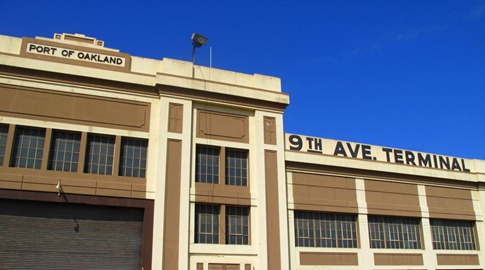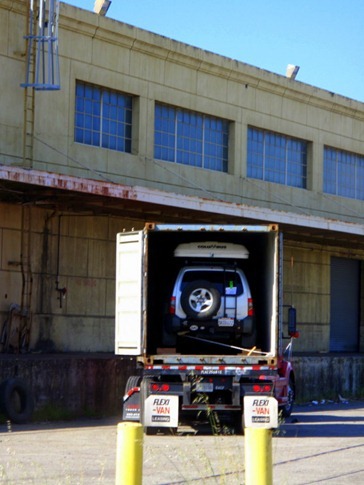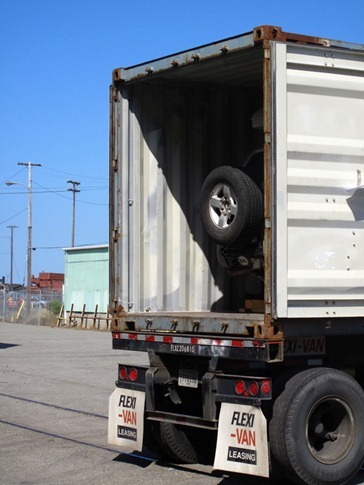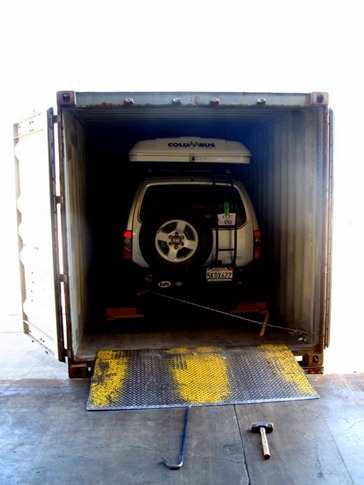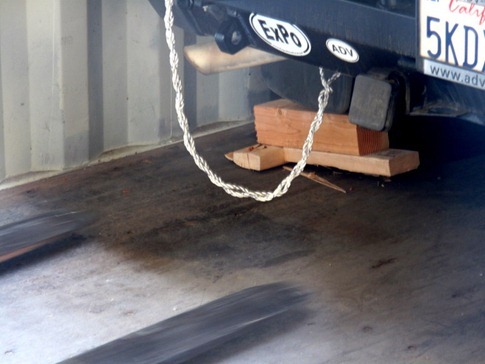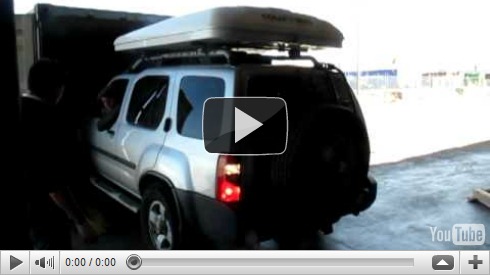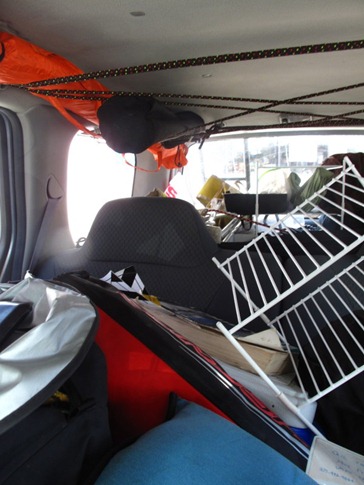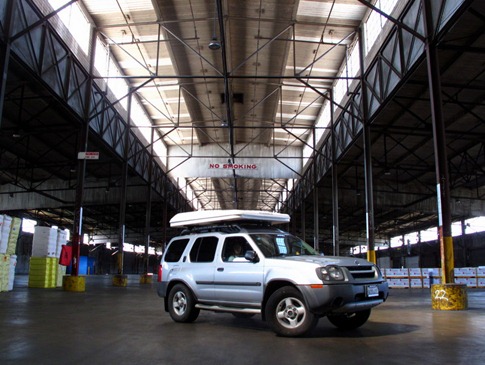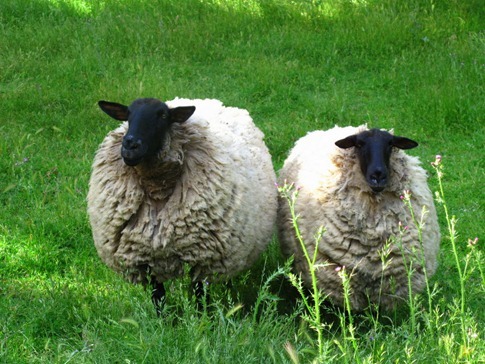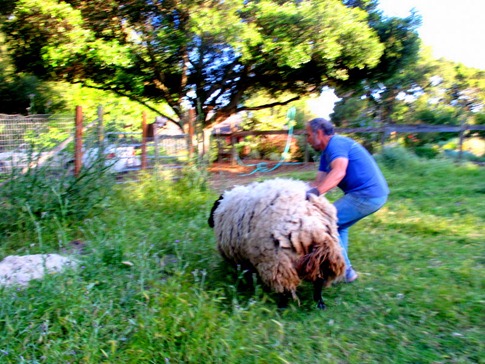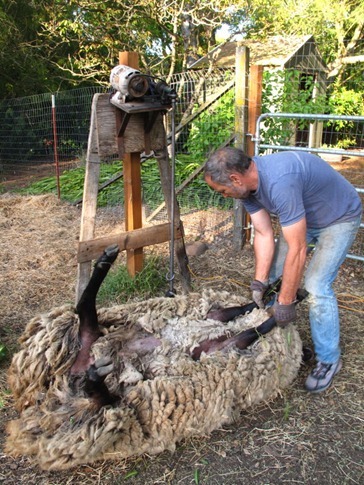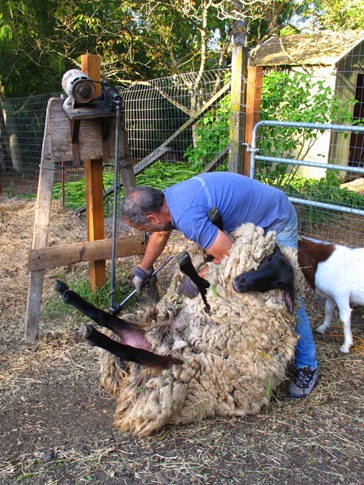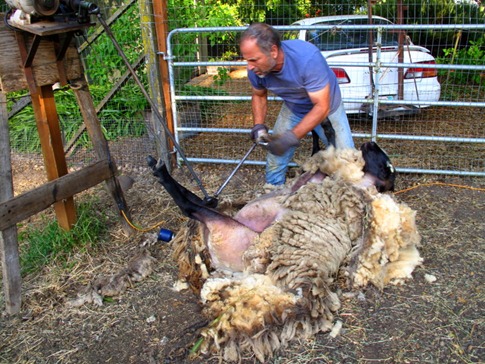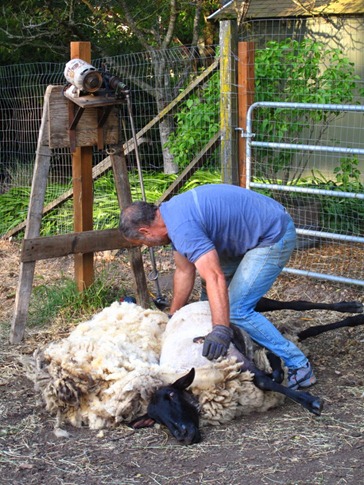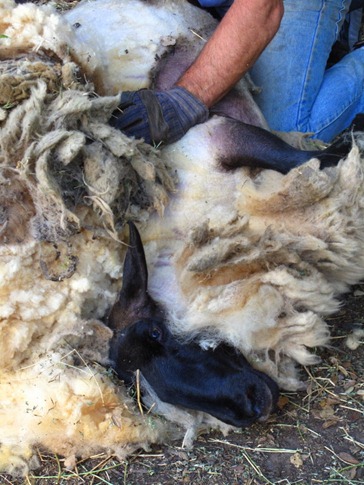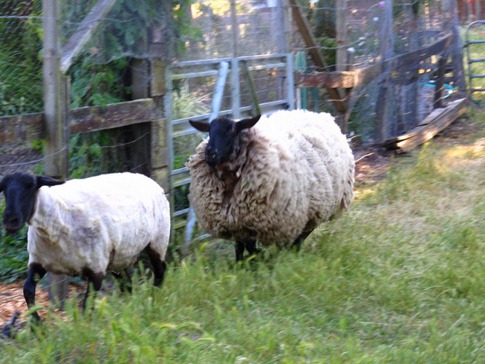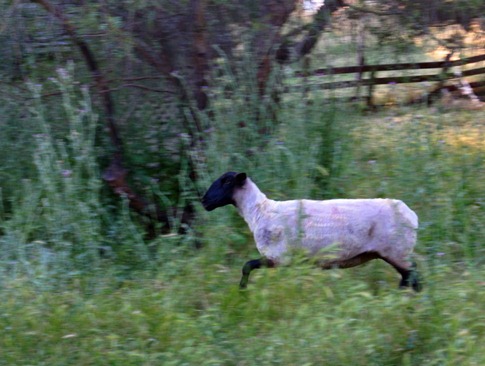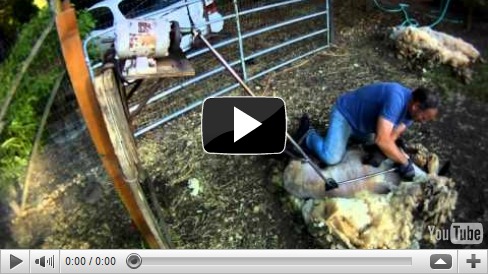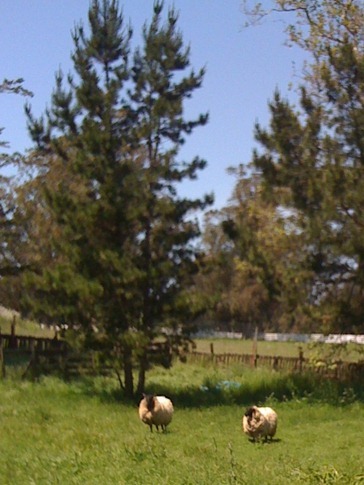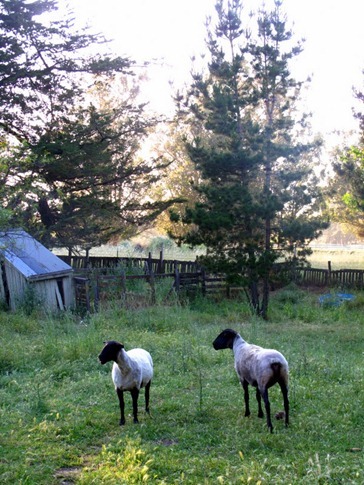I’d gotten an email from a woman named Sherri Aymes a couple weeks after we got home. Sherri worked for Hamburg Sud, the shipping company that owned the boat on which our truck was taking a two week long Pacific Coast cruise. There was no text in the email (or pictures of the Xterra sunning itself on the Lido deck or pigging out on shrimp at the midnight buffet) but amidst the abbreviated port names and long container numbers in the PDF documents attached, I was able to determine that our truck was to arrive into the Port of Oakland on Thursday, May 5th. It also appeared that from Colon the ship had sailed south to Cartegena, Columbia before returning back through the Panama Canal to the Pacific. Bizarre.
On Thursday morning, I called the 800 number in Sherri’s email signature for Hamburg-Sud North America and was surprised when it went straight to her. I explained that I’d gotten the email and needed to know how to get the truck. I like to think that my quip about this being a little more complicated than picking up a package at FedEx broke the ice, but either way, she was very friendly. And in a friendly way explained to me that I needed to overnight a cashier’s check to her for $400 to cover the “destination fees” at the Port of Oakland, to secure a customs broker and to get the truck off the port within four days or I would be charged storage fees. Yeah, that *is* a little more complicated.
Our shipping agent in Panama, Julio, had actually told me about the destination fee which I’d always assumed was akin to the undercoating charge on the invoice for a new car, so the only problem was the original “Bill of Lading” she also needed. Before disappearing off the bus and into the rain after returning from the port of Colon, Julio had hurriedly given me a stack of papers, but that seemed like months ago, and I hadn’t looked at any of the papers until now. Some of them referred to “loading,” but what the hell was “lading?” Just as I was considering whiting-out the extra “o,” I got an email back from Julio who confirmed that I did not need the original Bill of Lading because he’d filed some sort of release with Hamburg Sud which Sherri later confirmed. Okay, one problem solved.
On Friday, I called five or six numbers I found under a Google search on “customs broker port of oakland,” imagining dusty rotary phones ringing on solitary metal desks at the end of a rows of shelves towering into infinity. Most were answered in broken English with a promise of a call back. Others were just completely confused about what I needed; Had I bought a car in Panama? It would have to be registered. Where was the car manufactured? There will be taxes because it wasn’t made in the US. How long had I worked in Panama? What?! When I hadn’t heard back from anyone who seemed to know what I needed by the end of the day on Monday, I called Julio and Sherri in a panic, imagining $1000 a day storage charges due to a cigar smoking guy in a barred cashier’s cage under a freeway overpass somewhere. They put me in touch with someone from American International Transport who sent me about 10 customs forms to fill out including inventories of everything in the truck and something called an “ISF.” A quick search revealed that since January of 2010, any container loaded on a vessel without previously filling out an ISF could be fined $5000. Nice, I’ll fill that out right away then.
Two weeks later, after countless calls and emails between the customs broker, the shipping agent, the shipper and me, a date was set to pick up the truck. While we had somehow avoided storage fees, American International Transport emailed me an invoice for $3,000 for customs inspection fees, their time to “attend” the inspections (which I had told them repeatedly I would like to do myself), transportation of the container to a loading dock, $500 for “unblocking” and another $400 for destination fees. Why did this feel more corrupt than Panama? While I was able to prove to them that I had already paid the destination fees to Hamburg Sud, no amount of whining could convince them all I needed was the container on the ground, a crowbar to remove the blocks securing the truck and a couple two by fours as steps to drive it out. I reluctantly paid about $2,500 to release the truck, the same amount we had already paid for the entire shipping.
On May 23rd, 46 days after we had loaded the truck into the container in Colon, we drove to the Port of Oakland to retrieve it.
By then, our container had probably been moved five or six times and was now on a truck across the parking lot from a loading dock high enough for it to be offloaded. Never mind that it had been driven straight into the container on the ground in Panama.
The first attempts at removing the blocking, pieces of wood nailed into the wooden floor of the container to secure the wheels, with a sledgehammer and crowbar weren’t successful. The forklift driver, who also owned the huge warehouse, managed to jam a fork of the powerful hydraulic beast underneath the wood and pry it up.
While everyone assured me that the gas tank would have been drained and the battery disconnected for safety, I squeezed into the narrow container alongside the truck and barely wiggled in via the driver’s door. I put the key in the ignition, and she started right up.
The inside was pretty much trashed. Completely turned upside down. Padlocks cut, everything out on the seats. Corrupt dock workers in Panama? Nope, US Customs. I added a mound of colorful expletives to the pile of trash in the back seats, cursing the customs broker we used for not allowing me to attend the inspections at which I would have had all the keys. And yes, if we’d been allowed to put the truck in the container ourselves in Panama and seal it using the very special secure plastic dongle that I’d almost left the port with, I wouldn’t have felt like I needed to lock everything. No one there in the warehouse with us had anything to do with any of this and looked genuinely concerned when the mild-mannered newlyweds started cussing wildly.
In the end, nothing was missing and they’d actually been careful to cut as few locks as possible. They just could have put stuff generally back where they found it. After 7 borders and largely good experiences, we decided to just chalk it up to the cost of doing business.
Back at the farm – note that I don’t really feel comfortable calling it a “farm” since I know there are real, hardworking people who run very productive farms and we don’t actually grow anything here yet but we do have pastures and a garden in development and that’s what everyone else calls it so… – we had scheduled an appointment with a sheep shearer. The two Suffolk sheep we’d acquired with the property had thick matted wool that made them look like cotton balls with black heads. On every low hanging branch or bit of barbed wire around the lower pasture, bits of wool dangled like tinsel on a discarded Christmas tree.
We’d been told that the previous owner had never sheared them because he couldn’t catch them. And in fact, despite their portly appearance, they could still get up a head of steam and charge around the pasture, reminding you that they were powerful animals. But the shearer, a guy we’d found through a reference from the agent who represented the previous owners, sounded confident that it wouldn’t be a problem. While we were concerned that the thick layer of insulation would be a problem for the sheep in the summer heat, he explained that the real problem is them getting wet or muddy during the winter and not being able to stand up under the weight.
The shearer pulled through our front gate like he owned the place, swung his white Ford Taurus around and backed up to the pasture gate. On a trailer hitch was a wooden A-frame contraption which he’d unloaded and secured to a fence post before even acknowledging us. To the frame he attached a small electric motor and to that a long articulated arm that looked like it'd belong to lanky pre-pubescent robot. On the end was a vintage shaver with alternating comb-like teeth which he oiled meticulously from a can that looked like a prop from “The Wizard of Oz.” His whole set up had a sort of frantic mad scientist feel, but that contrasted sharply with his scruffy facial hair and bulging biceps. I began to wonder if he’d concocted some potion in his basement laboratory that was slowly turning him into a wolf. The determination with which he stomped off into our pasture towards the petrified sheep only supported my hypothesis.
Each time they charged powerfully around the edges of the pasture to evade their predator, he’d adjust his course and continue pursuit, never breaking from an insistent plodding march that showed no doubt that success was inevitable. He explained later that in most domesticated breeds of sheep, including the Suffolk’s we had, the fight had pretty much been bred out. Any animals that were too difficult to catch for shearing were instead chosen for “processing,” the preferred euphemism for slaughter, and thus removed from the gene pool. In fact, some animals were now so devoid of instinct that they’d simply lay down and allow themselves to be eaten by a coyote.
Finally he got one into a corner where, sure enough, it just collapsed and awaited its fate. Only problem was, the shearer needed the sheep over near his shears. To get it back on its feet, he rolled it onto its back and then all the way over the other direction. When its feet touched the ground on the other side, it instinctively stood up and started to run. Grabbing two handfuls of wool, the shearer could run beside it and steer it where he wanted. It reminded me of an old-timey cop grabbing a guy wearing black and white stripes by the collar and running him to the “hoosgow.”
Once in position by the shears, the sheep was rolled onto its back and then propped up onto its butt.
Then, moving methodically from the hind legs towards the front along one side, the shearer freed the thick wool from the sheep like he was taking off a jacket.
The sheep definitely had to be restrained during the process but seemed fine other than some heavy breathing from the earlier attempts at escape.
Turns out the first sheep he’d grabbed, the bigger one, was actually a wether, a neutered male. When he was let up, he ran to find his companion but now looked tiny in comparison. When the second was caught, we learned that it was a female. Maybe brother and sister?
Check out the whole process with the second sheep.
We asked the shearer what he thought we should do with the wool. We knew that Suffolk wool was not particularly sought after, especially when matted with… well, let’s call it “mud.” He said we could probably put it on CraigsList and someone who didn’t know what they were doing might pick it up before realizing they now had a useless, stinking mess on their hands. He mentioned a couple other uses – as insulation in outbuildings and as weed cloth in the garden - but we decided we’d bring this batch to the county compost and get crafty with the next.
Before:
After:
As the shearer was packing up, we realized we hadn’t asked him how much it would cost. I think we pay like $45 to get 25 lb Gorilla’s toenails cut at the vet and this was a much bigger animal, a lot more work and a house call. I was really prepared for just about anything up to a couple hundred bucks. His response? $20 for the trip and $2 per animal. What a deal. I’d never paid so little for sheep shearing in my life! Never mind that I’d never had sheep.
At the Port of Oakland, we’d felt a little like a sheep chased into a corner; Our only choice, it seemed, was to lie down and roll over. But at the same time, getting the truck back felt like a weight had been lifted, and we could make a fresh start. On the farm, we were making the place our own and having a positive effect on it. 0ne chapter officially over and a new one well underway.

